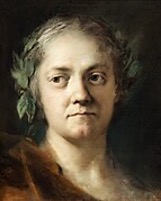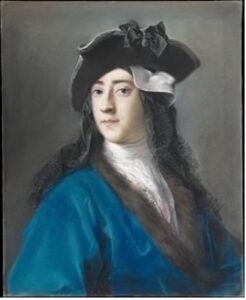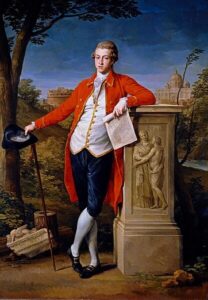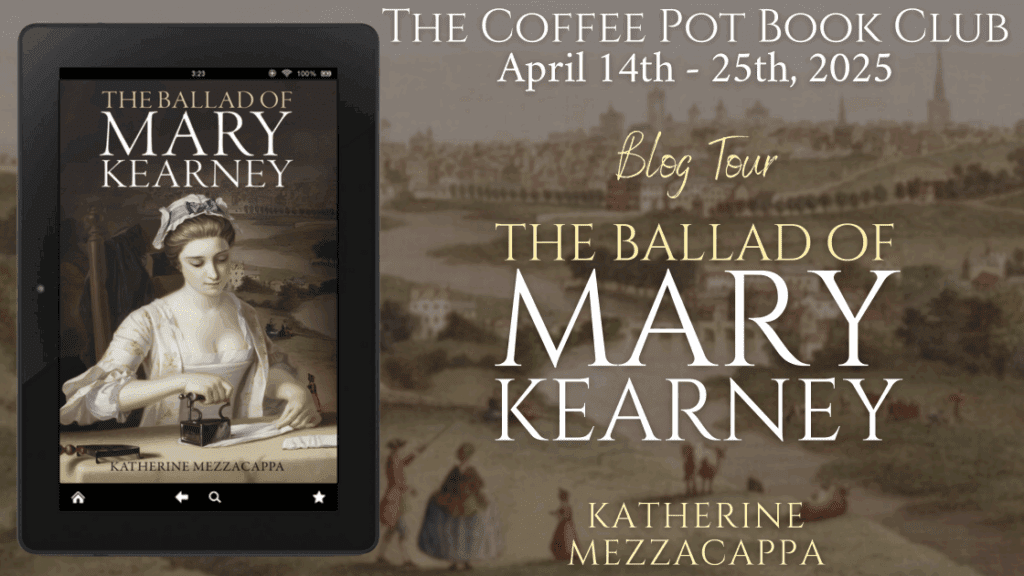ABOUT THE BOOK
‘I am dead, my Mary; the man who loved you body and soul lies in some dishonorable grave.’
In County Down, Ireland, in 1767, a nobleman secretly marries his servant, in defiance of law, class, and religion. Can their love survive tumultuous times?
‘Honest and intriguing, this gripping saga will transport and inspire you, and it just might break your heart. Highly recommended.’ Historical Novel Society
‘Mezzacappa brings nuance and a great depth of historical knowledge to the cross-class romance between a servant and a nobleman.’ Publishers Weekly.
The Ballad of Mary Kearney is a compelling must-read for anyone interested in Irish history, told through the means of an enduring but ultimately tragic love.
Here is Katherine to talk about the book:
‘But one object was I able to save from the wreckage of their bedroom—a likeness of Lord Goward when Viscount done by a pastellist in Venice after the manner of Rosalba—wearing a domino and a look of mischief.’
The hero of my story, James Goward, in common with many Ascendancy gentlemen and contemporaries of their class in Britain, made his Grand Tour of the continent, from which he returns just before the novel opens. In Rome, he follows the practice of many Grand Tourists, and was painted full-length by Pompeo Batoni (or as James’s mother refers to him in correspondence, ‘Mr Battoney’: ‘the painting looks very fine with him gesturing at all those ruins as if he had discovered them himself.’) with the finished canvas being delivered to Ireland months later. In Venice, he sits for his portrait in pastels. Rosalba Carriera (1673-1757) was dead by the time James made his tour, so I had him depicted by one of her imitators, in the style of her 1730 portrait of the young Irish nobleman, Lord Boyne.

Image Rosalba Carriera:
Self portrait of Rosalba Carriera, c. 1743-1747
Accademia Gallery, Venice
Rosalba Carriera was the daughter of a Venetian lawyer and was initially trained in that most Venetian of feminine roles, lace making, but for economic reasons she turned first to painting miniatures on the lids of snuff boxes before proceeding to portraits in pastels. Her two sisters worked as her assistants. She was sought out by the Grand Tourists. As her sitters included Maximilian II of Bavaria, Frederick IV of Denmark and Augustus the Strong, King of Poland and Elector of Saxony, her fame spread beyond her native city. She worked in Paris in the early 1720s (where she painted Louis XV) and in 1730 was at the court of the emperor Charles VI in Vienna, as well as travelling through northern and central Italy. Rosalba, as she was generally known, outlived all her family, but in her later years was afflicted by the worst disability a painter could have: she underwent failed operations for cataract and went blind.
Rosalba, in common with other women artists who are only now taking their rightful place in the pantheon, has sometimes been sidelined by art historians (though the variable popularity of the Rococo style has had something to do with this). John Steer, author of a standard text, A Concise History of Venetian Painting, granted her a paragraph and one illustration. He acknowledged that she was ‘internationally the most important of Venetian eighteenth-century portraitists’ and that she impacted the development of French artists of the period, like Boucher and Greuze, but described her portraits as having ‘a sweet, surface elegance, but little concern with depth of character’ and noted her ‘idealized figures of pretty women in a variety of allegorical roles.’ Her self-portrait in the Accademia in Venice suggests anything but ‘surface elegance’, and she certain appears to have considerable depth of character.
What’s next for Katherine?
I intend to return to Venice, about which I have written before, in a novel I am planning on the life of the feminist writer Lucrezia Marinella (1571-1653) and her milieu of the literary and philosophical academies which flourished in the city in her time.
Works by Rosalba Carriera:

Image Viscount Boyne:
Gustavus Hamilton, 2nd Viscount Boyne
Rosalba Carriera, 1730
Metropolitan Museum of Art, New York
 Image Baronet Dunstanville :
Image Baronet Dunstanville :
Francis Basset, 1st Baronet de Dunstanville
Pompeo Batoni, 1778
The sitter is shown against a backdrop of the Castel Sant’Angelo and St Peter’s, but Basset never received the finished portrait. The ship on which it was travelling was seized by the French and the painting was sold to the Spanish. It is now in the Prado, Madrid.
Source: Wikimedia Commons
Buy The Ballad of Mary Kearney
About Katherine Mezzacappa
 Katherine Mezzacappa is Irish but currently lives in Carrara, between the Apuan Alps and the Tyrrhenian Sea. She wrote The Ballad of Mary Kearney (Histria) and The Maiden of Florence (Fairlight) under her own name, as well as four historical novels (2020-2023) with Zaffre, writing as Katie Hutton. She also has three contemporary novels with Romaunce Books, under the pen name Kate Zarrelli.
Katherine Mezzacappa is Irish but currently lives in Carrara, between the Apuan Alps and the Tyrrhenian Sea. She wrote The Ballad of Mary Kearney (Histria) and The Maiden of Florence (Fairlight) under her own name, as well as four historical novels (2020-2023) with Zaffre, writing as Katie Hutton. She also has three contemporary novels with Romaunce Books, under the pen name Kate Zarrelli.
Katherine’s short fiction has been published in journals worldwide. She has in addition published academically in the field of 19th century ephemeral illustrated fiction, and in management theory. She has been awarded competitive residencies by the Irish Writers Centre, the Danish Centre for Writers and Translators and (to come) the Latvian Writers House.
Katherine also works as a manuscript assessor and as a reader and judge for an international short story competition. She has in the past been a management consultant, translator, museum curator, library assistant, lecturer in History of Art, sewing machinist and geriatric care assistant. In her spare time she volunteers with a second-hand book charity of which she is a founder member. She is a member of the Society of Authors, the Historical Novel Society, the Irish Writers Centre, the Irish Writers Union, Irish PEN / PEN na hÉireann and the Romantic Novelists Association, and reviews for the Historical Novel Review. She has a first degree in History of Art from UEA, an M.Litt. in Eng. Lit. from Durham and a Masters in Creative Writing from Canterbury Christ Church. She is represented by Annette Green Authors’ Agency.
Author Links:
Website: https://katherinemezzacappa.com/
Facebook: https://www.facebook.com/katherinemezzacappafiction
LinkedIn: https://www.linkedin.com/in/katherine-mezzacappa-09407815/
Instagram: https://www.instagram.com/katmezzacappa/
Bluesky: https://bsky.app/profile/katmezzacappa.bsky.social
Amazon Author Page: https://www.amazon.com/author/katherinemezzacappa
Thank you to Katherine and The Coffee Pot Book Club for this interesting post.


Thank you so much for hosting Katherine Mezzacappa today, with such an interesting article linked to her evocative new novel, The Ballad of Mary Kearney.
Take care,
Cathie xx
The Coffee Pot Book Club
Thank you, Deborah, for hosting me today